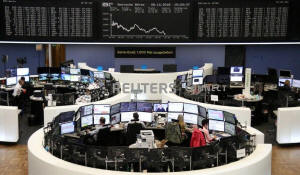|
Aussie dollar goes down under as global
slowdown forces RBA shift
 Send a link to a friend
Send a link to a friend
 [February 06, 2019]
By Virginia Furness [February 06, 2019]
By Virginia Furness
LONDON (Reuters) - The Australian dollar
nosedived after its central bank opened the door to a possible rate cut
in a remarkable shift from its long-standing tightening bias, a further
indication of global economic slowdown.
The policy shift caught some investors off-guard as only just the
previous day the RBA had steered clear of an easing signal when holding
its official cash rate at a record low 1.50 percent for the 30th
straight month.
The Australian dollar plunged 1.5 percent overnight and was set for its
biggest daily drop in a year.
Elias Haddad, rates and FX strategist, at Commonwealth Bank of Australia
said that while there was a risk the Aussie dollar could test $0.70, a
more pronounced downward move was unlikely.
"As a bank we have pushed out our call for a 25 basis point rate hike by
one year to November 2020 from November 2019," he said.

Australia’s central bank is the latest to signal policy easing in the
face of global economic headwinds.
Last week, the U.S. Federal Reserve all but abandoned plans for further
rate hikes, citing slowing global growth as a risk to the world's top
economy. The European Central Bank has also sounded less certain that it
will start tightening later this year.
Donald Trump's combative State of the Union address added to the gloom
on markets as the U.S. president unveiled no new infrastructure
initiatives and instead raised the prospect of another shutdown should
financing not be forthcoming for the wall on the U.S.-Mexico border he
wants to build.
As such the dollar settled near a two-week high.
In the annual speech outlining his priorities for the coming year, Trump
said illegal immigration was a national crisis and reiterated his vow to
build the border wall.
Futures trading indicated a weaker open to the U.S. stock markets with
the S&P down 0.16 percent, and Nasqad down 0.07 percent.
The MSCI world equity index, which tracks shares in 47 countries, was
last down 0.07 percent at around 0900 GMT.
European stocks markets opened slightly in negative territory as a fresh
new batch of earnings failed to lift spirits after Trump's address
touched on trade and budget issues but provided investors with few
insights.
Banks were the biggest drag on the STOXX 600, with shares BNP Paribas
down 1.6 percent after France's largest-listed lender lowered its profit
and revenue growth targets for 2020 after a tough fourth quarter.
[to top of second column]
|

The German share price index DAX graph is pictured at the stock
exchange in Frankfurt, Germany, October 8, 2018. REUTERS/Staff

Germany's DAX opened 0.2 percent lower, France's CAC 40 was down 0.4
percent and Spain's IBEX fell 0.1 percent. The euro zone blue chip
index fell 0.3 percent.
EUROPE DRAGS
Further weak data from Europe prompted demand for core euro zone
bond yields as investors pushed back expectations that the European
Central Bank will hold back from rate hikes.
German industrial orders fell unexpectedly on weak foreign demand in
December, data showed on Wednesday, a further sign that companies in
Europe's largest economy are struggling with a slowing world economy
and trade disputes.
Investors will also be looking to the European Commission's winter
macroeconomic forecasts, due to be published on Wednesday or
Thursday. Large downward revisions to growth and inflation are
likely, according to analysts at Societe Generale.
"The EC forecast will give a pretty good guideline of how much the
ECB will revise their own economic forecasts," said CBA's Haddad.
German 10-year government bond yields, the benchmark for the region
opened one basis point lower on Wednesday at 0.16 percent, well off
the 0.21 percent highs hit on Tuesday.
Italian debt was in focus with the Treasury planning to sell a
30-year bond via a syndicate of banks. Italian 30-year government
bond yields jumped to three-week highs at 3.678 percent as investors
sold bonds to make way for the new issue.
Sterling meanwhile was a shade lower at $1.2930 after losing nearly
0.7 percent on Tuesday on weak Purchasing Managers Index data for
Britain and uncertainty about Brexit talks.

U.K. Prime Minister Theresa May will travel to Brussels on Thursday
to tell EU leaders they must accept legally binding changes to the
Irish border arrangements of Britain's divorce deal or face a
disorderly no-deal Brexit.
(Editing by Jon Boyle)
[© 2019 Thomson Reuters. All rights
reserved.]
Copyright 2019 Reuters. All rights reserved. This material may not be published,
broadcast, rewritten or redistributed.
Thompson Reuters is solely responsible for this content. |